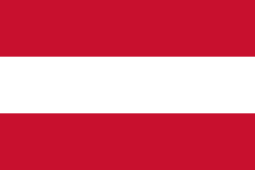Flag of Austria
 |
|
| Use | Civil flag and ensign |
|---|---|
| Proportion | 2:3 |
| Adopted | 1918 |
| Design | A horizontal bicolor triband of red (top and bottom) and white. |

Variant flag of Austria
|
|
| Use | State and war flag, state and naval ensign |
| Proportion | 2:3 |
| Design | A horizontal triband of red (top and bottom) and white defaced with the Coat of arms of Austria at its centre. |
The flag of Austria has three equal horizontal bands of red (top), white, and red. The Austrian triband is based on the coat of arms of the Babenberg dynasty, recorded in the 13th century. It may have seen use in flags from about the 15th century, alongside the black-and-yellow colors of the House of Habsburg and other insignia of the Holy Roman Empire. It was adopted as a naval ensign in the 18th century, and as national flag in 1918.
The flag traces back to the coat of arms of the medieval Babenberg dynasty, a silver band on a red field (in heraldry: Gules a fess Argent). The origin of the Bindenschild has not been conclusively established, it possibly derived from the Styrian margraves of the Otakar noble family, who themselves may have adopted the colours from the descendants of the Carinthian duke Adalbero (ruled 1011–1035), a scion of the House of Eppenstein extinct in 1122. However, the Babenberg margrave Leopold III of Austria (1095–1136) had already been depicted with a triband shield in 1105.
When the last Otakar Duke Ottokar IV of Styria died in 1192, the Styrian duchy was inherited by the Babenberg duke Leopold V of Austria according to the 1186 Georgenberg Pact. According to the 18th century historian Chrysostomus Hanthaler, his grandson Duke Frederick II of Austria (1230–1246), nicknamed the "Quarrelsome" or the "Warlike", the last of the Babenberg dynasty, designed a new coat of arms in red-white-red after his accession—an attempt to prevail against reluctant local nobles and to stress his autonomy towards Emperor Frederick II. The triband is first documented in a seal on a deed issued on 30 November 1230, confirming the privileges of Lilienfeld Abbey. The medieval chronicler Jans der Enikel reports that the duke appeared in a red-white-red ceremonial dress at his 1232 accolade in the Vienna Schottenstift.
...
Wikipedia
